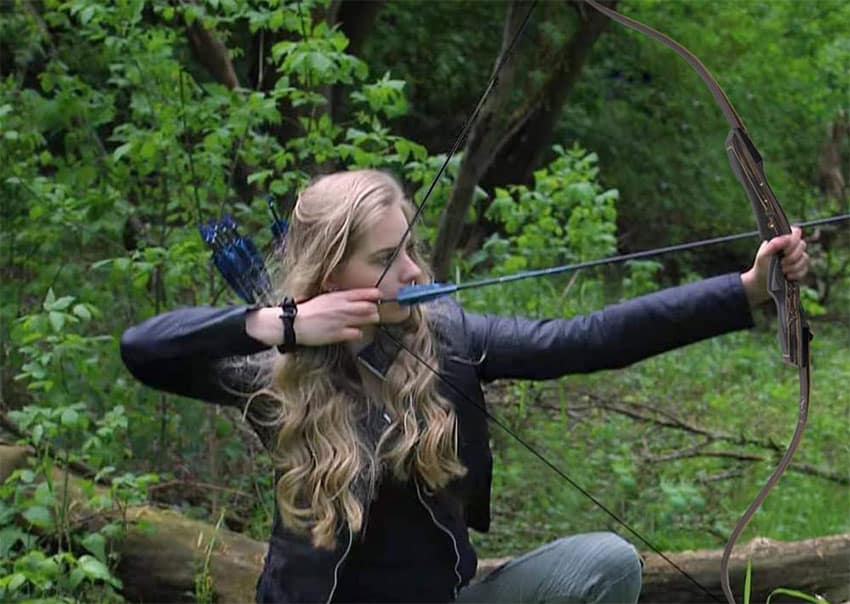Today's most well-known classic bow is the recurve bow. A recurve's reflex design allows it to shoot arrows instantly. The large size of the riser keeps a recurve bow stable in hand, preventing hand shock. Recurves are accurate because they are usually cut to the center so that the arrow points directly where you are shooting.
Traditional recurve bows are available as one-piece headshot bows in various lengths and weights. They are perfect for beginners because they are easier to shoot, and many come with a bearing for adding accessories to your bow.

Table of Contents
Parts of a recurve bow?
A recurve bow consists of a bow riser, limbs, and a string. When a recurve bow is unstrung, it will disassemble into three parts for easy transport and adaptability. The "riser," which is usually made of metal but can also be made of wood or carbon, is where you grip the bow. The top and bottom sections are referred to as "limbs," and they are made of wood, fiberglass, carbon, and other materials.
Below is a brief on the important parts of a bow and the purpose they serve:
1. The Riser
A riser is a central component of a recurve bow where the archer's fingers rest on the bow. Many types of risers are made from various materials that affect the weight and feel of the bow. In general, fiberglass or carbon fiber will produce a lighter bow that shoots arrows with greater force.
A bow's riser connects the bow limbs to the handle and is shaped to accommodate the bowstring. It serves as a platform for the limbs and provides the necessary clearance for the string when drawn. To emphasize the point, a recurve bow riser serves as the foundation upon which the archer builds. A recurve bow riser serves as the base from which the archer shoots the arrow, which is why a riser must be well-built and sturdy in order to function correctly.
2. Limbs
The riser (bow handle), grip (grip on one end of the bow limb), and forearm are the three main components of a recurve bow limb (hold on the other end of the bow limb). In other words, limbs are the parts of the bow that allow it to bend back on itself and form a "recurve" shape.
These limbs serve various purposes, but their primary function is to store the energy produced during a single draw, releasing it all at once.
3. Bowstring
Bowstrings are made from various materials, but they all serve the same purpose. The material employed in it is determined by personal preference and sports requirements. For example, a fiberglass bowstring would be ideal if you enjoy archery. For hunting, however, a more durable, weather-resistant material is required.
How is it different from the conventional bow?
A recurve bow differs from the traditional bows in terms of their characteristics. A conventional bow has a single string that runs between two limbs (the part of the bow that folds whenever the string is pulled). It's typically shot without sight by pulling back on the string. It's a tool that's been around for thousands of years, and its efficiency has stood the test of time.
In contrast, recurve bows store energy in the limb when the string is drawn back, after which the arrow is accelerated forward, releasing the string and making the limbs snap forward. The more power is stored in the limbs of the bow, the heavier the draw weight becomes.
However, the smoothness of a bow varies greatly depending on its length and design, as well as the shooter's stature.
What is the recurve bow used for?
Archery has evolved from a hunting activity into a sport that boasts high prestige while retaining precision and accuracy values.
This bow is known for its extensive use in target archery and Olympic games, as it is the only style of bow permitted for use in competition.
A recurve archer pushes back the string towards their face through their fingers and aims towards the target with the help of their unprecedented focus. The arrow is then released down the line towards the target.
Recurve archers use short and long rods to stabilize the bow, which helps in breezy weather conditions and keeps the bow stable when the arrow is released.
What makes it the best bow for beginners?
Recurve bows are simple to pick up and shoot as a beginner. There is less equipment and intricate detail, and most people are generally familiar enough to get started quickly. Beginner recurve bows are also ideal for honing your form and technique. Smooth and convenient recurve bows allow the archer to refine their abilities and increase draw weight as they keep improving.
However, just because they're simple to shoot doesn't mean they're simple to aim accurately. Shooting a recurve with consistent accuracy is difficult unless you put in many hours of focused training.

